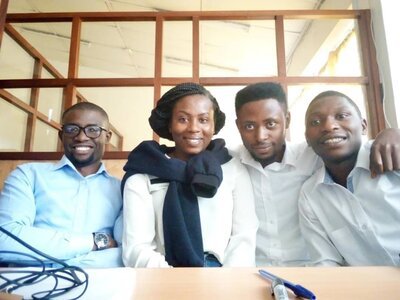Communities of practice can be important to the effective operation of any organization, but they become crucial to those organizations that understand that knowledge is an important asset to nurture. Knowledge in this case is created, shared, organized, and updated within and among communities. This informal gathering of people into a community and their shared practice makes the organization more effective and able to meet its mission. In particular, communities of practice help ensure the sustainability of new initiatives, trainings and projects. A community of practice is characterized by social relationships (the community), continual development of skills (shared learning), and the use of those skills through sharing of resources, information and knowledge (the practice).
Why is the community of practice concept crucial to the Center of Excellence in Biodiversity and Natural Resource Management? The Rwanda Biodiversity Information System (RBIS) that we are creating with our partners has many moving parts. Data on Rwanda’s biodiversity are scattered across many countries in a large variety of formats, making it very difficult to use them as is. New species are being identified, the conservation status of species is regularly updated, and taxonomy is in flux. There is a web platform that requires IT expertise to maintain and upgrade as needs, technologies, users and priorities change. There are data needs that shift and change as new policies, strategies, development needs, or environmental phenomenon arise. Spatial layers are being constantly updated. Different communities and institutions need to have access to the RBIS and know how to use it and ensure it remains functional for their needs. Particular skills are needed for each moving part to function well and to be integrated into the whole. We are relying on a community of practice for the creation of the Rwanda Biodiversity Information System (the RBIS).
A community of practice, or CoP, means there will be a group of people working together on various aspects of the RBIS to ensure that it remains functional and relevant. This includes individuals from biology, forestry, nature conservation, IT, GIS, geography, conservation science, natural resource management and policy. Hours of training need to be invested in the group in order to build their capacity to clean and mobilize biodiversity data records, to harvest data from various sources, to adapt software as system needs change, to identify spatial layers and make them available in the system portal, and to identify data product needs to augment policy development and implementation. The individuals in the group need to talk to each other and learn from each other.
The benefits of a functioning CoP include:
Practice, or the collaboration with others which enables us to test ideas, get feedback and interact in ways that we may not if we were working or learning alone; and
Connections, meaning the relationships we make during this learning process within our own institution and with other institutions and partners, not only help each of us, but also assist those outside the community of practice as we become more effective.
We recognize the need to have a community of individuals who are passionate about this work for the RBIS, so that when one individual leaves, there are others who can step in and continue the work because they have received the training, are part of the community, and care about the practice. This helps to ensure that the system stays dynamic, functional, and relevant.
If you would like to learn more about our Community of Practice in biodiversity data management, please contact Beth Kaplin at b.kaplin@ur.ac.rw or +250 788664551 or Mapendo Mindje at majulesdor@gmail.com.
To read more about Communities of Practice:
FAO. Communities of Practice: A Practical Guide. http://www.fao.org/elearning/course/fk/en/pdf/trainerresources/pg_cop.pdf
Hildreth P., C. Kimble, and P. Wright. 2000. Communities of practice in the distributed international environment. Journal of Knowledge Management 4(1): 27-38. https://arxiv.org/ftp/cs/papers/0101/0101012.pdf
Mercieca, B. 2017. What Is a Community of Practice? In Communities of Practice: Facilitating social learning in higher education, Pages 3-25. DOI: 10.1007/978-981-10-2879-3_1
https://www.researchgate.net/publication/310360237_What_Is_a_Community_of_Practice
Mohajan, H.K. 2017. Roles of Communities of Practice for the Development of the Society Journal of Economic Development, Environment and People 6(3):1-23 https://mpra.ub.uni-muenchen.de/82954/1/MPRA_paper_82954.pdf
Tweet
